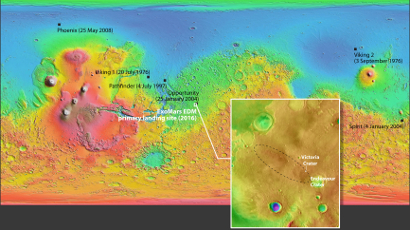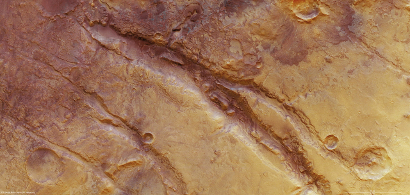Inside ExoMars - Quarterly Newsletter
Issue 3 - May 2011
| What’s new for this quarter: | |
| - |
ExoMars 2018 mission revised: ESA and NASA agree to send one rover to Mars.
|
| - |
The European industrial consortium responsible for developing the ExoMars spacecraft have delivered the financial proposal for the next phases of the Programme (C/D/E1) to ESA.
|
| - |
Instrument payloads making good progress.
|
A new concept for the 2018 ExoMars mission
This quarter has concluded with several important developments for the ExoMars Programme. These include the decision to fly one rover to Mars in 2018, which will be equipped to meet the scientific goals of both agencies.
Originally, the 2018 mission concept of the ESA-NASA ExoMars Programme consisted of two rovers, one developed by ESA and the other by NASA, with complementary payloads and objectives. In addition to a rover, NASA was to provide an Atlas launcher and a sky crane (delivery system) similar to that developed for NASA's MSL mission. In late March, NASA announced that budget limitations have impacted its planned contributions for future joint space missions, including Mars exploration; as a consequence, the 2018 mission of the ExoMars Programme has been revised.
In the new scenario, a single rover, to be developed jointly by ESA and NASA, will be equipped to satisfy the combined objectives of the initial dual rover concept. This single rover may be larger than the existing ESA rover design and will require significant design changes to make it compatible with the NASA landing system, since the latter requires the rover to land on its wheels rather than on a platform, as foreseen for the original ESA rover. NASA has agreed to provide the launcher, the cruise stage, and the landing stage for the new rover concept.
A Joint Engineering Working Group, comprised of ESA and NASA engineers, has been convened by ESA and NASA in order to establish an architecture for the sharing of responsibilities for the revised 2018 mission. The ultimate goal is to arrive at a configuration for a rover that profits from the best contributions of the two partners. A number of intensive studies are expected to be completed by the end of this year by which time a mutually agreeable configuration can be established and agreed with the participating Member States of the ExoMars Programme.
|
|
 |
|
|
Proposed landing site for the 2016 ExoMars mission
Credit: MOLA Science Team and NASA/JPL/Arizona State University |
Industry delivers financial proposal for upcoming phases
ESA received the financial proposal for the upcoming C/D/E1 phases (covering manufacturing and testing of all mission components up to the full deployment of the mission elements) on 14 February 2011. The proposal has been prepared by the European industrial consortium, led by the prime contractor, Thales Alenia Space - Italy, based on the documentation delivered for the System Preliminary Design Review in December 2010, and it takes account of the amendments introduced as a result of the Review Board's conclusions.
The financial proposal included both missions of the ExoMars Programme and was based on the mission concept developed by the international partners over the past year. While some reorientation is now expected for the 2018 mission, as a result of the recent changes to the rover concept, it is anticipated that the 2016 mission will proceed to the implementation phase, once negotiations between ESA and industry to achieve an acceptable cost for the ExoMars Programme have been successfully concluded.
Updates on payloads
The five payload instruments of the Trace Gas Orbiter, due for launch in 2016, will perform remote observations of the Martian atmosphere, searching for evidence of gases of possible biological importance. Development of these instruments is underway and the Experiment Interface Requirements Document, providing the requirements guiding their development and accommodation, has been issued by ESA to all the principal investigators.
In the meantime, the proposals for the Entry, Descent and Landing Demonstrator Module (EDM) science sensors and instrumentation are under evaluation. The final selection will be announced by the beginning of this summer. These sensors will monitor the behaviour of all key technologies during the mission, including the thermal protection, parachute system, and a liquid propulsion braking system. The data will be sent back to Earth for post-flight reconstruction to support the development of future European missions to Mars. The EDM will also deliver a small science package that will operate on the surface of Mars for a short duration.
The design activities for the instruments of the 2018 mission are ongoing, though some modifications may be necessary during the current study period to account for the definition of the new single rover.
|
Save the Date |
|
|
13-15 June Lisbon, Portugal |
Exploring Mars Habitability
|
|
16-17 June Lisbon, Portugal |
1st International Mars Exploration Program Analysis Group (MEPAG) meeting
|
|
12-16 September Alaska, U.S.A. |
Fifth International Conference on Mars Polar Science and Exploration
|
|
2-7 October Nantes, France |
European Planetary Science Conference – Division of Planetary Sciences Joint Meeting 2011
|
|
For more information, you can also access the complete
Events Archive |
|
|
ExoMars Timeline 2011 |
|
| February |
Financial proposal for the next phases of the programme (C/D/E1) received by ESA
|
| April-June | Selection of the ExoMars 2016 Entry, Descent and Landing Demonstrator Module payload |
| July |
Start of Implementation Phase (C/D) for ExoMars 2016 mission
|
| April - December |
ESA-NASA Joint Exploration Working Group studies to establish an architecture for the joint single rover mission in 2018
|
|
For more information, you can also access the complete ExoMars timeline
Disclaimer: Future milestones are indicative and subject to change
|
|
To stay informed about the ExoMars activities, subscribe to our mailing list.
| ESA – ExoMars Programme | Don McCoy |
RoboticExploration esa.int esa.int |
ExoMars Project Manager |

